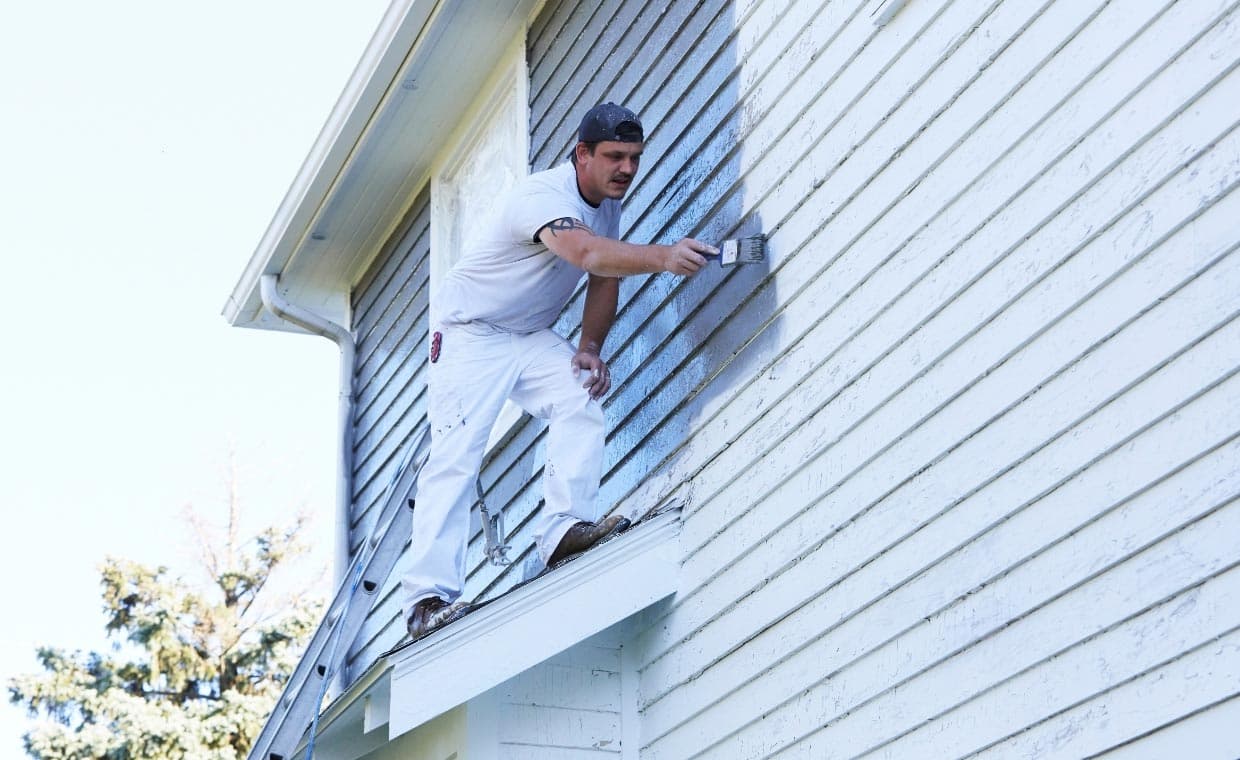
Exterior siding is one of the most important elements of a home’s structure, as it protects the interior from weather conditions, provides insulation, and contributes to the overall aesthetic. Over time, siding can become damaged, faded, or worn, requiring repairs and repainting to restore its functionality and appearance. Professional Columbus, Ohio, house painters play a key role in ensuring the home’s visually appealing and well-maintained exterior. We will explore how role of professional painters for repairing & painting exterior siding contribute to repairing and painting, concentrating on the significance of their skills and the methods they use to achieve lasting results.
Role of Painters for Repairing & Painting Exterior Siding
1. Assessing the Condition of the Exterior Siding

Before any painting work can begin, the condition of the exterior siding must be thoroughly assessed. This step is paramount in pinpointing areas that demand repair or replacement, such as cracks, rot, or damaged boards. Professional painters are well-versed in inspecting siding for these issues and can determine the appropriate course of action based on the extent of the damage. A detailed assessment ensures that any underlying problems are addressed before the painting begins. This approach causes further damage to the home and enhances the paint job’s longevity. Homeowners can expect this assessment to include checking for moisture damage, peeling paint, and any structural weaknesses in the siding material, as these factors can significantly impact the overall project.
2. Repairing Damaged Siding Before Painting

Once the assessment is complete, the next step is to repair any damaged sections of the siding. It is important to address these issues before applying paint, as painting over damaged or deteriorating siding can usher in poor results and additional problems. Depending on the type of siding, repairs may involve patching cracks, replacing wood sections, or sealing gaps to prevent moisture from entering. Professional painters often work closely with repair specialists to ensure the siding is fully restored before the painting begins. This step is paramount because it ensures the surface is smooth, even, and ready for paint application. Properly repaired siding looks better and provides a stronger foundation for the paint, which helps protect the home from the elements.
3. Preparing the Surface for Paint Application

Preparation is key to achieving a high-quality, long-lasting paint finish on exterior siding. After the necessary repairs are completed, professional painters take various steps to prepare the surface for paint application. This process typically involves cleaning the siding to remove dirt, dust, and mildew that can interfere with paint adhesion. Power washing is a common method used to clean the siding thoroughly, ensuring that the paint will bond properly to the surface. In addition to cleaning, the painters may sand down rough areas or old, peeling paint to assemble a smooth surface. If the siding has any imperfections, these are addressed during preparation to ensure an even and flawless finish. Priming the surface is often the final step in preparation, as primer helps the paint adhere better and provides an additional layer of protection against weathering.
4. Choosing the Right Type of Paint for Exterior Siding

Selecting the right type of paint for exterior siding is a paramount decision that can affect both the appearance and durability of the home’s exterior. Professional painters are knowledgeable about the distinct types of paints available and can recommend the most suitable option based on the material of the siding and the local climate conditions. For instance, certain paints are formulated to withstand extreme weather, such as high humidity or intense sunlight, making them ideal for homes in regions with harsh climates. The choice of paint finish, whether it be matte, satin, or gloss, also plays a role in the overall look and maintenance of the siding. Professional painters consider all these factors to ensure that the paint enhances the home’s appearance and provides long-term protection against environmental elements.
5. Applying the Paint for a Smooth and Even Finish

Once the surface has been repaired, cleaned, and primed, the actual painting process begins. Achieving a smooth and even finish on exterior siding requires skill and attention to detail. Professional painters use diverse techniques, such as spraying, rolling, or brushing, to apply the paint evenly across the surface. The method utilized often depends on the type of siding and the desired finish. For instance, spraying is commonly used for large, flat surfaces, while brushing may be preferred for more intricate areas. Painters apply multiple coats of paint to ensure full coverage and durability. They may lightly sand the surface between coats to extract imperfections, creating a flawless finish. The goal is to achieve a seamless look that enhances the home’s curb appeal while providing a protective layer that can withstand the elements.
6. Ensuring Long-Term Protection and Durability

The role of professional painters extends beyond simply applying paint to the siding. Their work also focuses on ensuring the long-term protection and durability of the exterior. This involves using high-quality paints and materials specifically designed to withstand the challenges of outdoor conditions, such as UV rays, rain, and temperature fluctuations. Additionally, professional painters properly seal joints and edges to stem moisture from seeping into the siding, which can cause damage over time. By paying close attention to detail and using the right techniques, professional painters help extend the lifespan of the paint job and the siding itself. Homeowners can rest assured that their home’s exterior is protected from weather-related wear and tear for years.
7. The Importance of Proper Cleanup and Final Inspection

After painting, professional painters also handle the cleanup and final inspection. Cleanup is an important part of the project, ensuring the home’s neat surroundings. This includes withdrawing protective coverings, disposing of unused materials, and ensuring no paint residue is left behind. Once the cleanup is finished, a final inspection is conducted to ensure that the paint job meets the homeowner’s expectations and that there are no missed areas or imperfections. Professional painters take pride in their work, and this final step authorizes them to confirm that the project has been completed to a high standard. Homeowners can expect a detailed walkthrough of the finished work, allowing them to provide feedback and ensure they are satisfied with the results.
Also Read: The Impact of Professional Painters on Home Renovations






























